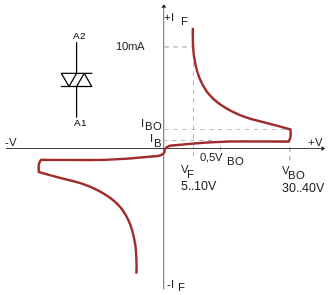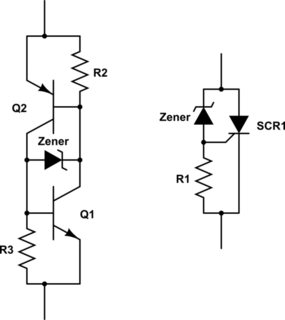Post History
No, two zener diodes are not equivalent to a DIAC. While they both have a specific breakdown voltage, the DIAC is a special 3-layer device that exhibits a negative resistance characteristic once it...
#2: Post edited
- No, two zener diodes are not equivalent to a [DIAC](https://en.wikipedia.org/wiki/DIAC).
- While they both have a specific breakdown voltage, the DIAC is a special 3-layer device that exhibits a negative resistance characteristic once it breaks down:
- 
- In contrast, the two zener diodes simply stop conducting once the voltage is reduced below the breakdown level.
In a typical phase-control dimmer, it is the charge on the timing capacitor that is used to trigger the TRIAC. The negative resistance characteristic of the DIAC is what allows this to happen. The back-to-back zener diodes would not pass enough current to trigger the TRIAC.
- No, two zener diodes are not equivalent to a [DIAC](https://en.wikipedia.org/wiki/DIAC).
- While they both have a specific breakdown voltage, the DIAC is a special 3-layer device that exhibits a negative resistance characteristic once it breaks down:
- 
- In contrast, the two zener diodes simply stop conducting once the voltage is reduced below the breakdown level.
- In a typical phase-control dimmer, it is the charge on the timing capacitor that is used to trigger the TRIAC. The negative resistance characteristic of the DIAC is what allows this to happen. The back-to-back zener diodes would not pass enough current to trigger the TRIAC.
- ---
- You can use a couple of SCR-connected transistors (or an actual SCR) to simulate the negative-resistance characteristic of a DIAC, but only in one direction. Each of these circuits only works correctly when the upper terminal is positive with respect to the lower. But you can work around that limitation by "wrapping" either circuit in a bridge rectifier.
- 
#1: Initial revision
No, two zener diodes are not equivalent to a [DIAC](https://en.wikipedia.org/wiki/DIAC). While they both have a specific breakdown voltage, the DIAC is a special 3-layer device that exhibits a negative resistance characteristic once it breaks down:  In contrast, the two zener diodes simply stop conducting once the voltage is reduced below the breakdown level. In a typical phase-control dimmer, it is the charge on the timing capacitor that is used to trigger the TRIAC. The negative resistance characteristic of the DIAC is what allows this to happen. The back-to-back zener diodes would not pass enough current to trigger the TRIAC.


















